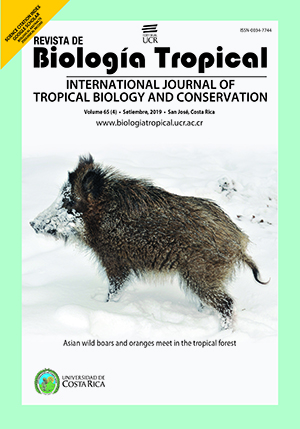Abstract
Rhipicephalus microplus, cattle common tick, transmits pathogens that affect the livestock production in tropical areas. For its control, pyrethroid compounds have been used whose inappropriate use has generated resistance in this tick. The study of the mechanisms of resistance to pyrethroids in R. microplus has shown the presence of mutations in genes related to its effect, either of enzymes that inactivate the compound or the sodium channels, the acaricide's target site. In Colombia, the first phase of the present project found a mutation in a hydrolyzing esterase in field populations of R. microplus resistant to pyrethroids. As it has been demonstrated that the resistance to chemicals in this tick is multigenic, in its second phase the project has as main objective to detect a polymorphism at position 2134 of the sodium channel gene. This mutation sustitutes a thymine for an adenine, T2134A, and has been previously related in other countries with pyrethroids resistance in carriers. For this, 182 R. microplus ticks were collected in two farms with history of resistance to this type of acaricides and they were subjected to the engorged female tick immersion test in a cypermethrin solution prepared at the recommended dose for field use obtaining six susceptible individuals, 92 resistant and 84 moderately resistant. DNA was extracted from all specimens by the phenol-chloroform method and was processed by conventional PCR using specific allele primers to amplify a segment of the IIIS6 domain of the sodium channel gene. The resulting amplicons were detected by electrophoresis in 2% agarose gels stained with GelRed® and visualized with ultraviolet light. In the same way, the sequencing of 20 samples obteined from the three susceptible, moderately resistant and resistant phenotypes was carried out and the resulting sequences were aligned through the Mega 7 program and compared with sequences stored in the GenBank®. Analyzes showed that the population of R. microplus studied did not present the expected mutation but a different mutation at site 2134. In the DNA of resistant and moderately resistant ticks, it was observed the substitution of a thymine for a cytosine, T2134C, that to the translation generates the change from a phenylalanine to a leucine, unlike the mutation previously reported that generates the change of a phenylalanine for a isoleucine. This shows the presence of a novel polymorphism that has not been reported in other studies with this tick species and that would generate a new molecular marker of pyrethroid resistance for populations of this mite.
Key Words: ticks; chemical resistance; pesticides; mutations; polymerase chain reaction
##plugins.facebook.comentarios##

This work is licensed under a Creative Commons Attribution 4.0 International License.
Copyright (c) 2019 EDGAR DIAZ RIVERA, Gisella Holguin Cespedes, Daniel A. Urrea Montes


